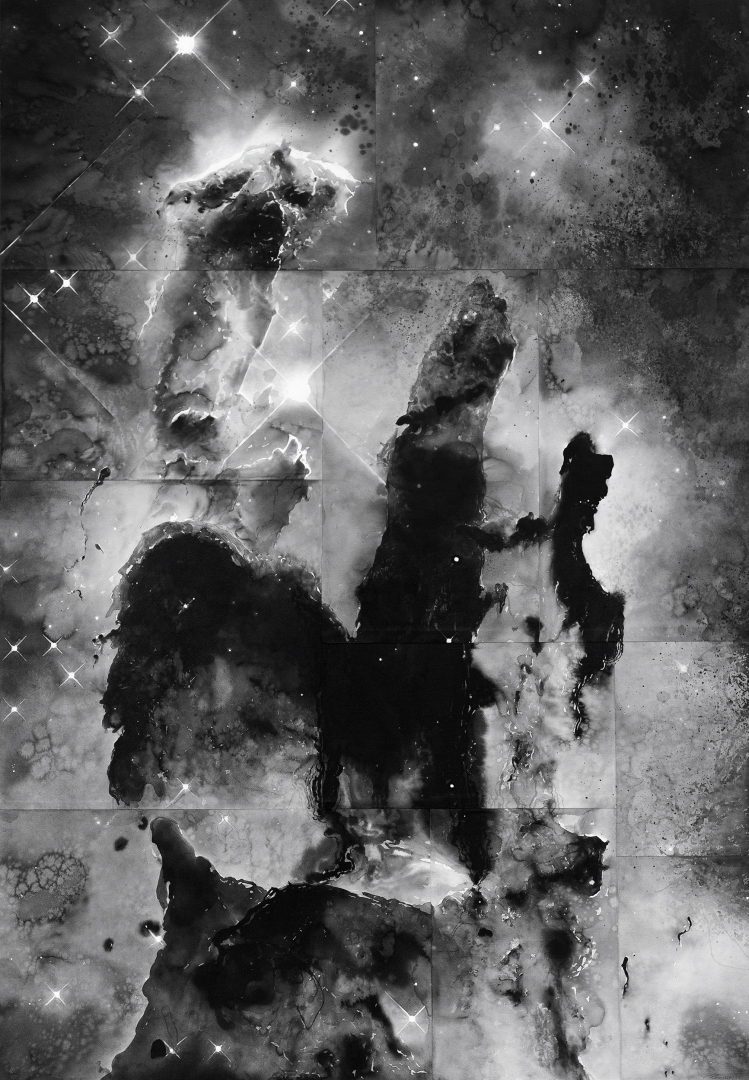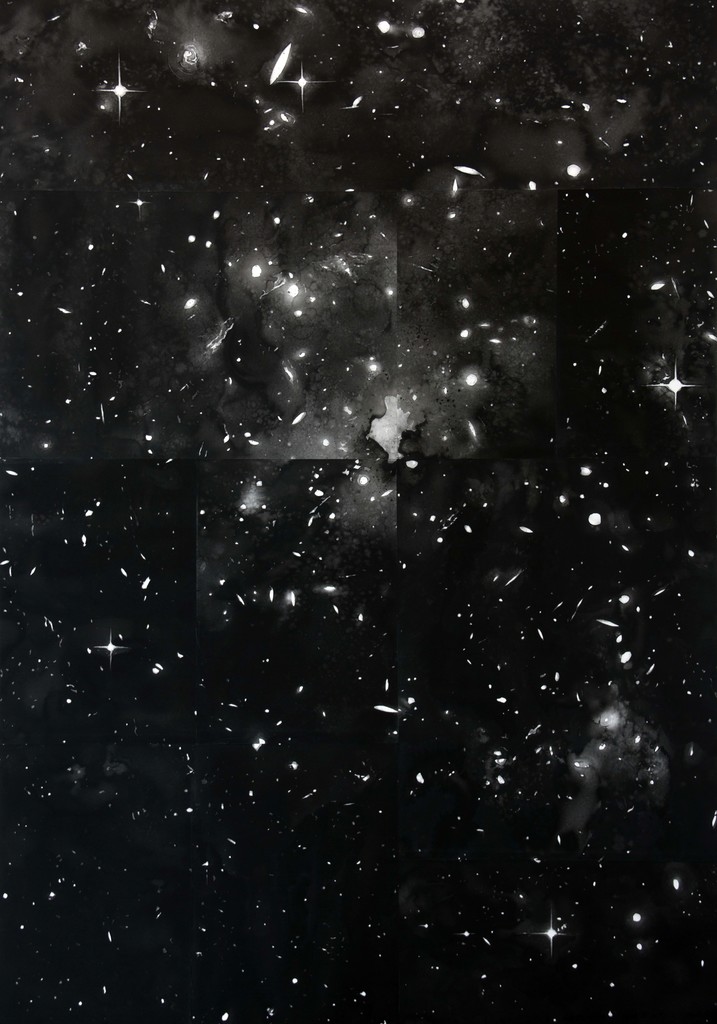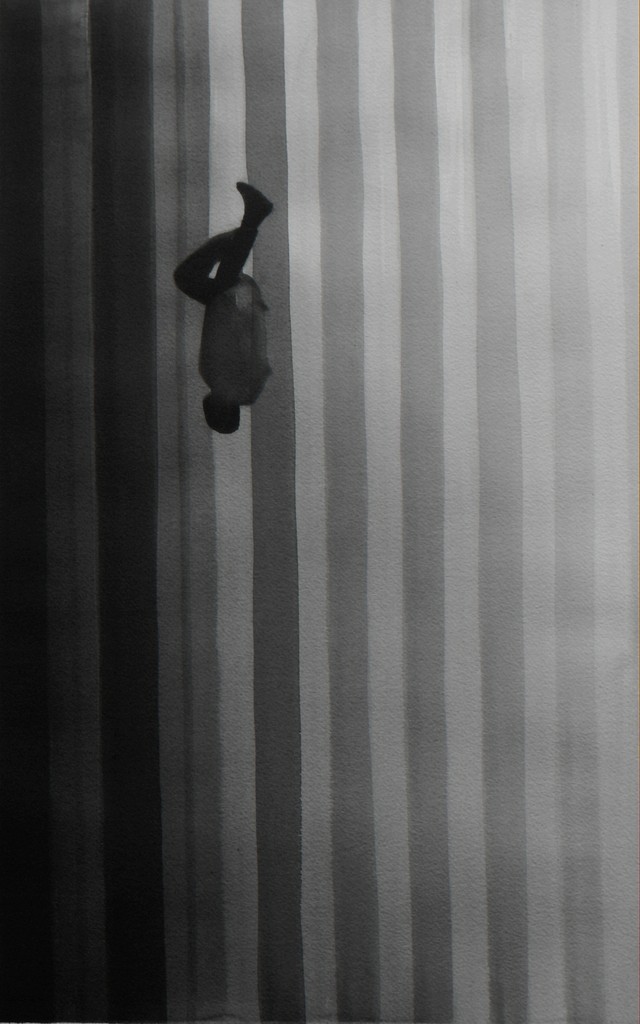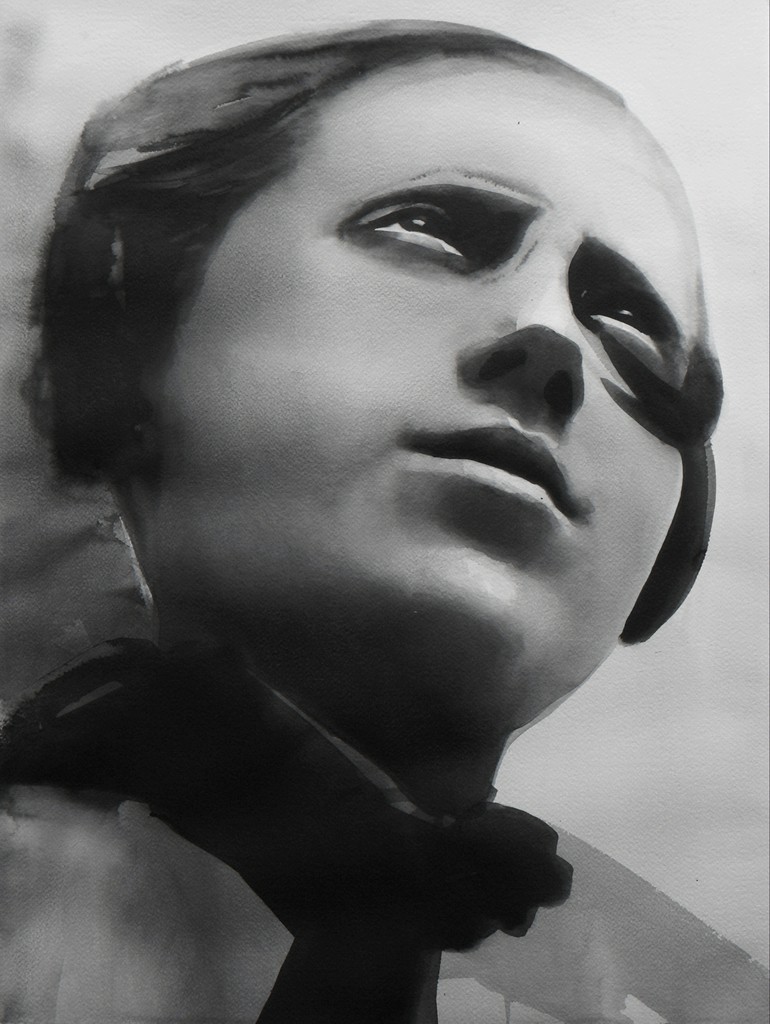FROM THE FAR SIDE OF THE MOON
Radenko Milak
June 10th – August 26th, 2017
ÜBER DIE AUSSTELLUNG
Im digitalen Zeitalter ist die Bildproduktion außer Kontrolle geraten. In jeder Sekunde werden Hunderttausende Bilder erstellt. Radenko Milak fragt nach unserem Bildgedächtnis im digitalen Zeitalter. Aquarell, Malerei, Zeichnung und jüngst auch ein gezeichneter Film sind die gegenwärtigen Ausdrucksmittel des Künstlers, der auf der diesjährigen Biennale in Venedig den Pavillon von Bosnien und Herzegowina bespielt.
DARK MATTER 2017
In Radenko Milaks zweiter Solo Show bei PRISKA PASQUER werden unter anderem vier großformatige Aquarelle präsentiert, die speziell für diese Ausstellung entstanden sind. Die Panels im Format 200 x 140 cm gehören zu den ersten Aquarellen, die der Künstler in dieser monumentalen Größe ausgeführt hat. Das neue Format haben sie mit einer anderen, zeitgleich in Venedig ausgestellten Werkgruppe gemeinsam. Thematisch geht es in den Kölner Arbeiten um Bildwelten, die wir nur durch modernste optische Verfahren sehen können. Nanomikroskope zeigen uns winzigste Strukturen, während das Hubble-Weltraumteleskop Bilder aus der unendlichen Weite des Universums liefert. Beide Welten liegen außerhalb unserer natürlichen Wahrnehmungsfähigkeit und zwischen diesen extremen Dimensionen spielt der menschliche Größenbereich eine verschwindende Rolle. Nur mit hoch-technologisierten Hilfsmitteln erreicht die Menschheit vermeintlich auch diese Sphären.
Wenn Radenko Milak einige dieser Mikro- oder Makro-Aufnahmen herausgreift und in monochrome Aquarellmalerei übersetzt, transformiert er den physikalisch-digitalen Prozess zurück in ein subjektives, hand-gemachtes, im traditionellen Sinne artistisches Medium. Durch diesen Akt stellt er die symbolische Macht und das ästhetische Potenzial der Bilder zur Disposition. Denn wir können diese Bilder zwar sehen, aber wir können sie nicht lesen. Es sind abstrakte Formationen und Fraktale aus einer anderen Welt, die sich letztlich unserem Zugriff entzieht. Die Werke lösen im Betrachter staunende Neugier aus. Die Erkenntnis von der Spannweite der kleinsten und größten Strukturen schüchtert ein und begeistert. Gleichzeitig stehen wir vor Werken, die mit ihrem malerischen Charisma und ihren symphonischen Schwarz-, Weiß- und Grauwerten beeindrucken.
FROM THE FAR SIDE OF THE MOON (VIDEO INSTALLATION)
Darüber hinaus wird Milaks Animationsfilm From the Far Side of the Moon vorgestellt sowie eine Auswahl der umfangreichen Kohlezeichnungen, die als Einzelbilder des Films entstanden sind. Der Film wird ebenfalls in Venedig gezeigt. Er entfaltet eine Folge höchst suggestiver Sequenzen, die ohne chronologische Erzählung vor allem durch ihre melancholisch-mystische Atmosphäre miteinander verbunden wirken. Es werden Landschaftsausschnitte sichtbar, in denen sich natürliche Bewegungen von Wasser, Luft, Rauch, Pflanzen oder Lebewesen aneinanderreihen. In anderen Einstellungen sind Menschen und der mechanische Rhythmus menschengemachter Maschinen dargestellt. Fragmente eines Interviews mit Robert Oppenheimer speisen die unterschwellige Dramaturgie bis zu ihrem düster-poetischen Höhepunkt. In dem Film versucht Milak einige Aspekte des atomaren Zeitalters zu erklären – und zwar auf der emotionalen, intuitiven Ebene – nicht auf der explizit politischen Ebene wie in seinen anderen Werken. Seit dem Anfang seiner künstlerischen Karriere ging Radenko Milak der Frage nach, wie die Medien unsere Erinnerung an Meilensteine, Tiefpunkte oder Sternstunden der technischen, politischen, gesellschaftlichen und kulturellen Entwicklung der Neuzeit beeinflusst haben.
Für die Realisation des 13-minütigen Films nahm sich der Künstler mehrere Monate Zeit. Die Entstehung erfolgte in verschiedenen Arbeitsprozessen, von der zeichnerischen Ebene über die fotografische Bearbeitung bis zur digitalen Stufe war ihm der experimentelle Spielraum wichtig. Den subtilen Soundtrack komponierte der französische Komponist und Pianist Gaël Rakotondrabe, der u.a. musikalischer Direktor in Robert Wilsons Stück The Life and Death of Marina Abramovic (2010-2013) war.
ÜBER DIE ZEICHNUNGEN
Grundlage des Animationsfilms From the Far Side of the Moon sind zahlreiche einzelne Kohlezeichnungen, die auf Aquarellpapier ausgeführt sind. Die Aneinanderreihung der Einzelbilder (‘frames’) mithilfe von fotografischen und digitalen Bearbeitungsstufen ergibt in der Summe den bewegten Film. Die Zeichnungen sind dabei eigenständige Werke und nicht nur Mosaiksteine eines größeren Ganzen, sondern auch unbewegte Augenblicke, die der Zeitgebundenheit des Films enthoben sind und ein Gefühl des Innehaltens vermitteln. Ausgewählte Blätter aus dem Gesamtkonvolut, die in unserer Ausstellung gezeigt werden, hat der Künstler zusätzlich mit Graphit und Bleistift mehrfach bearbeitet, um ihre Intensität und Tiefe individuell zu steigern. Sie werden so zu eigenständigen Trägern der melancholisch-mystischen Atmosphäre, die ebenfalls den Film prägt. So wie dieser eine lineare Erzählstruktur vermeidet, entfalten die Zeichnungen auch einzeln oder in kleinen Gruppen eine metaphernreiche, intensive Ausdrucksstärke.
ABOUT THE EXHIBITION
In this digital age, the production of images has spun out of control. Hundreds of thousands of images are created every second. Radenko Milak poses questions about our visual memories in the digital age. Watercolor, painting, drawing ‒ and most recently, an animated film ‒ are the means of expression which the artist is currently using in his exhibition for the Bosnia and Herzegovina pavilion at this year’s Venice Biennale.
ABOUT THE SERIES DARK MATTER 2017
In Radenko Milak’s second solo show at PRISKA PASQUER, he presents, among other works, four large-format watercolors which were specially created for this exhibition. The 200 x 140 cm panels are among the first aquarelles that the artist has completed in these monumental dimensions. They share this new format with another group of works which is being presented in Venice at the same time. Thematically, the Cologne works deal with pictorial worlds which we can only view by means of the most modern optical processes. Nano-microscopes show us the tiniest of structures, while the Hubble Space Telescope presents us with images from the endless expanse of the universe. Both of these worlds exist outside of our natural capacity for perception, and in between these extreme dimensions, the human size range plays an infinitesimal role. Only with the help of highly sophisticated technology can human beings presume to reach these other spheres.
When Radenko Milak selects a few of these micro or macro-images and translates them into monochromatic watercolor paintings, he is transforming the physical, digital process back into a subjective, handmade medium that is artistic in the traditional sense. In the act of doing so, he makes the symbolic power and aesthetic potential of the images available to the viewers. Although we can see these images, we cannot read them. They are abstract formations and fractals from another world, which ultimately escape our grasp. The works provoke astonished curiosity in the observer. Our recognition of the range between the smallest and largest of structures is both intimidating and thrilling. At the same time, we are presented with works that impress us with their painterly charisma and symphonic tones of black, white and grey.
ABOUT THE ANIMATION MOVIE
In addition to these pieces, Milak’s animated film From the Far Side of the Moon will be presented along with a selection of the numerous charcoal drawings that were produced as individual images in the film. The film will also be screened in Venice. It reveals a series of highly suggestive sequences which are primarily connected to one another through their melancholy, mystical atmosphere, without creating a chronological story. We see sections of landscapes in which the natural movements of water, air, smoke, plants or living creatures flow one after another. Other shots depict human beings and the mechanical rhythms of man-made machines. Fragments of an interview with Robert Oppenheimer support the underlying dramatic composition up to its somber and poetic climax.
In Radenko Milak’s second solo show at PRISKA PASQUER, he presents, among other works, four large-format watercolors which were specially created for this exhibition. The 200 x 140 cm panels are among the first aquarelles that the artist has completed in these monumental dimensions. They share this new format with another group of works which is being presented in Venice at the same time. Thematically, the Cologne works deal with pictorial worlds which we can only view by means of the most modern optical processes. Nano-microscopes show us the tiniest of structures, while the Hubble Space Telescope presents us with images from the endless expanse of the universe. Both of these worlds exist outside of our natural capacity for perception, and in between these extreme dimensions, the human size range plays an infinitesimal role. Only with the help of highly sophisticated technology can human beings presume to reach these other spheres.
When Radenko Milak selects a few of these micro or macro-images and translates them into monochromatic watercolor paintings, he is transforming the physical, digital process back into a subjective, handmade medium that is artistic in the traditional sense. In the act of doing so, he makes the symbolic power and aesthetic potential of the images available to the viewers. Although we can see these images, we cannot read them. They are abstract formations and fractals from another world, which ultimately escape our grasp. The works provoke astonished curiosity in the observer. Our recognition of the range between the smallest and largest of structures is both intimidating and thrilling. At the same time, we are presented with works that impress us with their painterly charisma and symphonic tones of black, white and grey.
In addition to these pieces, Milak’s animated film From the Far Side of the Moon will be presented along with a selection of the numerous charcoal drawings that were produced as individual images in the film. The film will also be screened in Venice. It reveals a series of highly suggestive sequences which are primarily connected to one another through their melancholy, mystical atmosphere, without creating a chronological story. We see sections of landscapes in which the natural movements of water, air, smoke, plants or living creatures flow one after another. Other shots depict human beings and the mechanical rhythms of man-made machines. Fragments of an interview with Robert Oppenheimer support the underlying dramatic composition up to its somber and poetic climax.
In the film, Milak attempts to explain certain aspects of the nuclear age – not at an explicitly political level as in his other works, but at an emotional, intuitive level. Ever since the beginning of his artistic career, Radenko Milak has pursued the question of how the media have influenced our memories of milestones, low points and great moments in the technological, political, societal and cultural developments of the modern era.
The artist devoted several years of work to the realization of this 13-minute film. The production took place in several different work processes: from the graphic level to the photographic processing to the digital phase, freedom and room to experiment was always important to him. The subtle soundtrack was composed by the Parisian pianist Gaël Rakotondrabe, whose credits include serving as musical director for Robert Wilson’s performance piece, The Life and Death of Marina Abramovic (2010-2013).
Radenko Milak was born in 1980 in Travnik in the former Yugoslavia and lives Banja Luka, Bosnia-Herzegovina. He studied at the arts academies in Banja Luka and Belgrade. His works have been presented in international solo and group exhibitions and included in prestigious collections such as the Folkwang Museum (Essen), Art Collection Telekom (Bonn), Agnès B. (Paris) and the National Gallery of Bosnia and Herzegovina (Sarajevo). In 2017, his work appears in the Bosnia and Herzegovina pavilion at the 57th Venice Biennale.

















